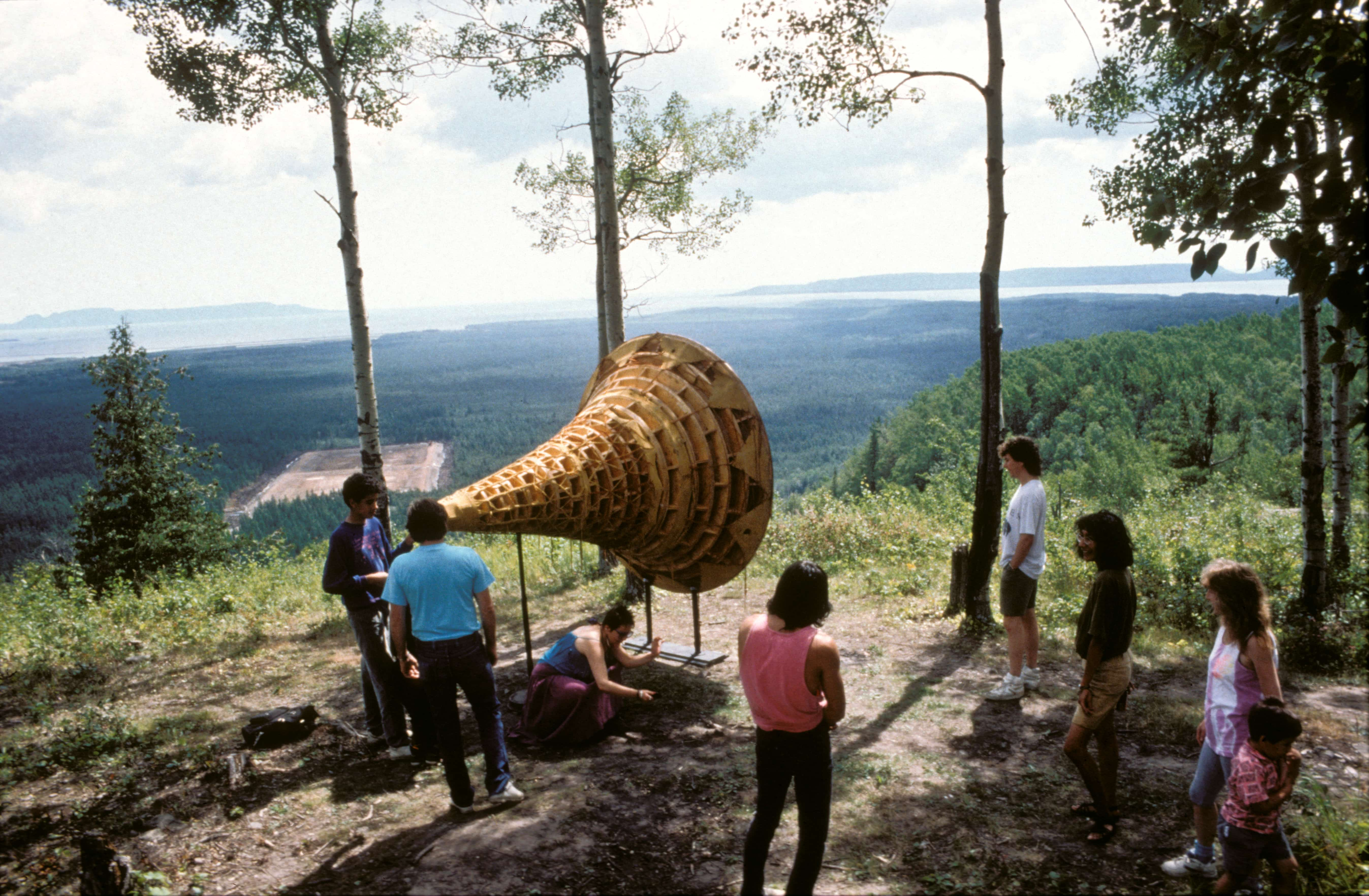
Rebecca Belmore, 'Ayum-ee-aawach Oomama-mowan: Speaking to Their Mother,' 1991. Gathering, Mount Mackay, Fort William First Nations, Thunder Bay, Ontario, 1992. Photo: Michael Beynon. Courtesy of Walter Phillips Gallery, Banff Centre for Arts and Creativity. Purchased with the support of the York Wilson Endowment Award, administered by the Canada Council for the Arts, P08 0001 S
Rebecca Belmore, Ayum-ee-aawach Oomama-mowan: Speaking to Their Mother, n.d.
Audio work composed of recordings from community gatherings in 1992; 26:33 minutes Edition 2 of 2
Collection of Walter Phillips Gallery, Banff Centre for Arts and Creativity
P21 0004 M
The audio work, Ayum-ee-aawach Oomama-mowan: Speaking to Their Mother (n.d.), shares its name with the iconic sculpture by artist Rebecca Belmore that has come to be recognized internationally as a potent symbol of Indigenous rights through its amplification of voice, protest, and song. Commissioned by Walter Phillips Gallery in 1991 with the fabrication of the piece at Banff Centre, the work was envisioned by the Anishinaabe artist in the wake of the Kanyen’kehà:ka Resistance of 1990, or “Oka Crisis” where conflict over the intention for a golf course to be built over Kanyen'kehà:ka burial grounds resulted in a militarized response from the Canadian government. Taking the form of a large megaphone constructed primarily of wood and tanned moose hide and embedded with a loudhailer, the work was intended to amplify the voices of Indigenous people in Canada and was first activated at a gathering in a meadow at Johnson Lake in Banff National Park where a group of over sixty people joined to either take up the artist’s invitation to speak through the work to the land or to witness. [1]
As the artist states in an interview from 2008 with curator Daina Augaitis, the use of the sculpture in the context of the mountains produced an echo that was of significance to the work. [2]
"For those who spoke, this effect conceptually integrated the sound of their own voices with the land. This magnificent experience of an echo made all who were gathered profoundly aware of the body as nature. […] The art object became merely a functional tool; the essence of the piece was the voice and its reverberation across the land." [3]
The recordings that compose this audio work are from a series of gatherings that took place in 1992, when the artist alongside Florene Belmore and Michael Beynon transported the work to a number of Indigenous communities across Canada in both urban and rural locations, beginning these travels with an event at the steps of Parliament Hill. [4] The gatherings with the work would begin with the artist speaking through the sculpture and would then be open to those present to speak or otherwise address the land. [5] Heard in the audio from these events are the sounds of a baby’s cry, words spoken to the earth, and music played or sung. In 2021, the artist donated the audio work Ayum-ee-aawach Oomama-mowan: Speaking to Their Mother to Walter Phillips Gallery, with the desire that when exhibited in future, the megaphone should be experienced alongside this work; reintegrating sound into the experience of the sculpture. Streaming online as a part of this exhibition, the words, sounds and songs of love and of protest are available now for all with means of accessing them to hear.
[1] Daina Augaitis and Rebecca Belmore, “Ayum-ee-aawach Oomama-mowan: Speaking to Their Mother: Daina Augaitis and Rebecca Belmore in Conversation.” Interview by Daina Augaitis. In Rebecca Belmore: Rising to the Occasion, edited by Daina Augaitis and Kathleen Ritter. Vancouver: Vancouver Art Gallery, 2008, 41.
[2] Daina Augaitis co-curated the Walter Phillips Gallery exhibition, Between Views and Points of View (1991) with Sylvie Gilbert through which Ayum-ee-aawach Oomama-mowan: Speaking to Their Mother was commissioned.
[3] Augaitis and Belmore, “Ayum-ee-aawach Oomama-mowan: Speaking to Their Mother: Daina Augaitis and Rebecca Belmore in Conversation,” 42.
[4] Ibid, 45.
[5] Ibid, 45.
Rebecca Belmore
Rebecca Belmore is a member of Lac Seul First Nation (Anishinaabe). Her works are rooted in the political and social realities of Indigenous communities and make evocative connections between bodies, land and language.
A major retrospective of Belmore’s work, prepared by the Art Gallery of Ontario, toured Canada in 2018-19. Her group exhibitions include Whitney Biennial (2022); dOCUMENTA 14 (2017), Athens, Greece; Echigo-Tsumari Triennial, Niigata Prefecture, Japan (2015); Global Feminisms, Brooklyn Art Museum, New York (2007); Land, Spirit, Power, National Gallery of Canada, Ottawa (1992); and Creation or Death: We Will Win, Havana Biennial, Cuba (1991).
Belmore was a recipient of the Gershon Iskowitz Prize in 2016 for her outstanding contribution to the visual arts in Canada, Governor General’s Award in Visual and Media Arts in 2013, the Hnatyshyn Foundation Visual Arts Award in 2009, and Honorary Doctorates from the Ontario College of Art and Design University in 2005, Emily Carr University in 2018, the Nova Scotia College of Art and Design in 2019 and the Université Laval in 2021.